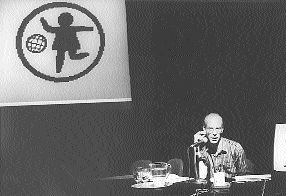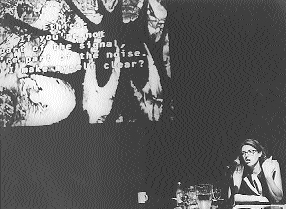Radical re-coding
Kathy Cleland reports on the ANAT-Performance Space Code Red

Geert Lovink, Code Red
photo Heidrun Löhr
Geert Lovink, Code Red
Code Red was the third in a series of Australian Network for Art and Technology initiated events over the past few years bringing international new media artists and theorists to Australia to engage with Australian practitioners and theorists. The previous initiatives, Virogenesis 1 & 2, curated by Francesca da Rimini, played on the metaphor of viral infection and replication, with international guests, Graham Harwood, Matt Fuller and E. “Gomma” Guaneri, spreading their own strain of subversive politicised commentary on new media culture and production and finding willing hosts and co-conspirators in the Australian new media community.
Building on the successes of these earlier events, Code Red, curated by Julianne Pierce, brought together an impressive lineup of international and Australian-based theorists and artists to interrogate and critique contemporary information culture. Following the theme suggested by its title, Code Red acted as a timely alert or call to arms for the Australian new media arts community drawing attention to the growing commercialisation and state/corporate control of contemporary media and information culture as well as suggesting strategies for intervention and resistance. It is only possible to give a small taste of these presentations here but if your tastebuds are stimulated keep an eye on the ANAT website http://www.anat.org.au/projects where the papers will be going up soon and you can find links to related websites.
In his keynote address, “Strategies for Media Activism”, Geert Lovink (Netherlands) outlined his personal commitment to “cyber pragmatism and media activism” in the face of an international climate of increasing media monopolies, surveillance and censorship. “New media is a dirty business, full of traps and seductive offers to work ‘for the other side’”, he cautioned, suggesting that artists and activists need to develop and defend spaces on the internet which are independent of both state and commercial interests. By way of example he discussed the practice of a number of autonomous organisations in Europe which are working to promote access to and critique of new media.
Jeffrey Cook (Australia) also spoke of the need for techno-activism and the importance of a critical art practice in maintaining “a radical position in the homogenous soup of mainstream media and information”. The imminent prospect of webTV threatens to undermine the most positive and productive feature of the internet, its facilitation of many-to-many communication with active participation by users to a dumbed down space for endless re-runs of sitcoms, commercials and infotainment. Free speech and expression of ideas on the internet are also under threat in Australia from a proposed web rating system that would require ISPs to ensure that all the websites they host carry a rating which will distinguish ‘safe’ from ‘unsafe’ websites. This would allow browsers to lock out ‘undesirable’ sites leading to further marginalisation of much of the more challenging and creative content.

Linda Wallace
photo Heidrun Löhr
Linda Wallace
In her presentation, “Luminous”, Linda Wallace (Australia) took a pragmatic approach to the vexed questions of corporate/state funding for artists, challenging notions that corporate money is “dirty” and state money “pure”. She emphasised the fundamental importance for artists of the work itself and “having the space and time and funds to create it”. She drew on her own experience of seizing opportunities in either the state or corporate sector and performing the difficult juggling act of “taking the funds but still having the space to speak freely”.
The final two presentations were by artists. Australian new media artist Brad Miller’s “Art in the Age of Collaboration” discussed and advocated the collaborative art practice that is a feature of much new media work such as Miller’s own collaboration with theorist McKenzie Wark in the production of the CD-ROM Planet of Noise. In “The Production of Visibility”, Cornelia Sollfrank (Germany) described strategies for parodying and subverting the power structures and advertising images of the media, business and public authorities. Using a technique of “over-coding”, she takes already existing media images from advertising and promotional material (a technique she calls “ready-aesthetics”) and subjects them to a process of “concept-hacking” to make visible their latent power-strategies. Cornelia is also a founding member of the German new media performance group Innen who use similar techniques and have successfully infiltrated European computer fairs posing as trade fair assistants handing out mousemats with subversive messages to unsuspecting delegates.
In addition to the main conference, Code Red included a number of artist projects and presentations in The Performance Space gallery. Visiting from Slovenia, Marko Peljhan’s exhibition and performance piece 178 EAST—ANOTHER OCEAN REGION was the culmination of a two week residency at The Performance Space researching Australian telecommunication laws and using satellite technology to intercept transmissions in the radio space above Australia. Part of this research resulted in a guest appearance by Adam Cobb (Visiting Research Fellow, Strategic and Defence Studies Centre, ANU, Canberra) and the grafting of a satellite dish onto the roof of The Performance Space. Marko’s performance elicited audience complicity as participants were required to sign a confidentiality agreement stating they would not seek to record or disclose any of the intercepted material they were eavesdropping on.
Also dealing with themes of surveillance and privacy was Australia-based Zina Kaye’s (Humble Under Minded) Psychic Rumble Part 2 which recorded and broadcast over the internet ambient sounds and mutated snatches of conversation from The Performance Space gallery. Another event taking place in the gallery on the day of the conference was an on-line performance The Word: The Wall directed by Ann Morrison exploring the anarchic lives and environments of three virtual characters.
One of the most productive and useful features of Code Red was its facilitation of on-going debate and discussion between conference delegates and participants. Issues raised in the conference itself were followed up on subsequent days with two roundtables. The first (led by Geert Lovink and Australian media theorist McKenzie Wark) focussed on new media theory and strategies for communication and critique, the second (led by Cornelia Sollfrank and Julianne Pierce) discussed cyberfeminist practice and the creation of a ‘global’ cyberfeminist movement, issues that were the focus of the First Cyberfeminist International held during last year’s Documenta X in Kassel.
A Code Red outcome of particular interest to the Australian new media community is the creation of a new Australian/Asia Pacific email mailing list. The list :::recode::: will be hosted by autonomous.org (System X) with support from ANAT and will be a site for critical commentary and debate by practitioners and critics on contemporary new media, online and digital culture as well as providing an outlet for publishing material online. Those interested in subscribing to the list or who want more information should contact the list moderator: owner-recode@autonomous.org [expired]
Code Red was a project of the Australian Network for Art and Technology and The Performance Space curated by Julianne Pierce with support from the New Media Arts Fund of the Australia Council, the Goethe Institut, ABC Radio and the Arts Law Centre of Australia.
RealTime issue #23 Feb-March 1998 pg. 23






